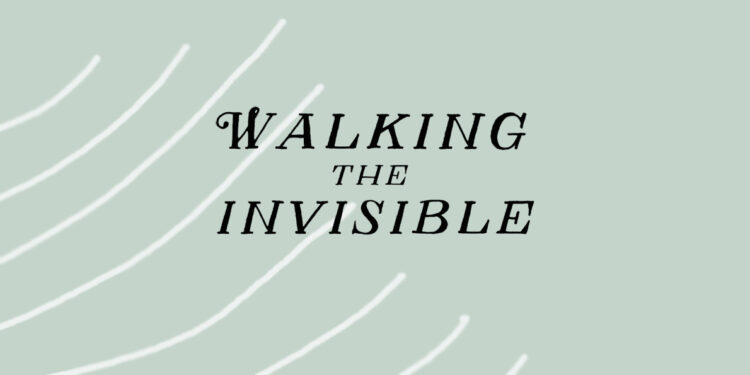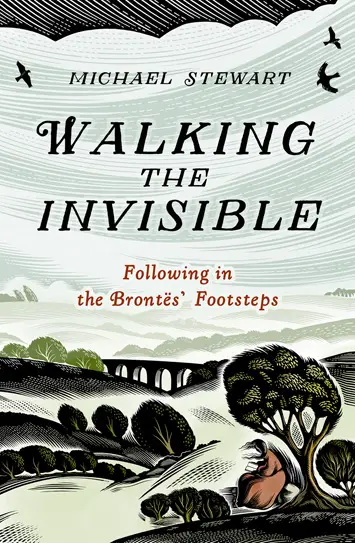Walking the Invisible: Following in the Brontës’ Footsteps by Michael Stewart – Review

By Barney Bardsley
This is the story of an author’s obsession. It is an obsession that many people share with him – a love, bordering on monomania, for the prodigious writing talents and extraordinary lives of the world-famous Brontë sisters. But Stewart has gone much further than just studying the works of Charlotte, Emily and Anne, plus that of their errant brother Branwell, and bookish father Patrick. He initiated the Brontë Stones project; pioneered special literary walks themed around each of the Brontë family members; and walked miles and miles and miles over moors and wild hills, to explore the expanse of Brontë territory – all with the aim of discovering what made these famous Victorians tick, and to get them and their work off the written page and back into the beating heart of life. The result of his labours is documented here, in a vivid book, full of anecdote, history, geography and psychological inquiry. Clearly an act of devotion and personal drive, the book is a complicated mixture, not always easy to follow, and somewhat offbeam in its approach. If you already know a great deal about the Brontës and want some of your preconceptions challenged, this may be the book for you.
The introduction is in some ways the most compelling part of the whole book. Here Stewart’s passion is laid bare with refreshing honesty. Born in Salford, and educated in a ‘failing comprehensive’, relegated to the ‘bottom class for English’ and therefore ‘not allowed to study the classics’, he left school at sixteen to start work in a factory. Every Saturday he visited his local library and took out books, which he would read on the bus journey to and from work each day. One of those books was Emily Brontë’s Wuthering Heights. And so it began.
Gradually he started reading novels by all the Brontës, then their poems and letters, their published and unpublished work. In time, Stewart even moved to Thornton – the birthplace of the Brontë siblings, before they moved to Haworth – and became interested in their lives, as well as their work. He began to tread the paths they would have taken, walking – and almost stalking – them into life, inside his own mind and body. As he roamed, he spoke his experiences into a dictaphone, creating the material for this book along the way.
In 2018, he started the Brontë Stones project. To celebrate the 40th anniversary of Kate Bush’s iconic single ‘Wuthering Heights’, he worked with the Bradford Literature Festival, to commission poems from four contemporary female writers: former Poet Laureate Carol Ann Duffy, Scottish Makar Jackie Kay, novelist Jeanette Winterson, and Kate Bush herself. The poems were then carved into stones in the Yorkshire landscape, and walking trails were devised, to take in these stones, and to represent the lives of the Brontë sisters – linking female creativity, past and present, and creating a bond between the literature and the land from which it arose.
“Plenty here to delight and to intrigue”
 At the end of the book, the hand drawn maps of these trails are included, with interesting titbits of information, and quirky pencil-drawn pictures alongside.
At the end of the book, the hand drawn maps of these trails are included, with interesting titbits of information, and quirky pencil-drawn pictures alongside.
What comes in between the introduction of the book and this delightful appendix of maps, is a sprawling narrative, in which Stewart intersperses his personal wanderings along the various Brontë trails, with memories and asides, bits of Brontë biography, conjecture about characters in the novels, historial fact and analysis, and random anecdotes about the people he meets on his travels. It is a confusing, though lively approach, which might flummox any reader not as intimately connected with the local geography – and the lives of the Brontës – as Stewart is himself. A more conventional, contextual overview, both of the landscape and of the lives of the main protagonists, would have been helpful. But there is plenty here to delight and to intrigue.
Not content with a conventional reading of the Brontë siblings’ lives, Stewart challenges received notions about each of his subjects. Was Charlotte really as strait-laced as she is sometimes portrayed, suppressing her sisters’ more provocative writings in the name of social decorum? Has Branwell, the errant only son of the family, been too harshly judged by history, as a good-for-nothing drunk? And who was the mysterious Anne in reality – ending her life, as she does, away from the family home in Scarborough, in what may have been a deliberate attempt to break free? Many questions are raised, too, about the content of the books themselves: most potently, on the character of Heathcliff, ‘whose cruelty echoes the moor’s indifference.’ Was he actually a descendant of black slaves, landed in the port of Liverpool, where Cathy’s father goes when he brings him back to the family home? This is an interesting racial and psychological slant, both on his treatment by the family, and his own troubled and brooding character.
Stewart knows that many of the questions he raises have no answers. As he writes, ‘Walking the Invisible is in some ways, about recording an absence. It’s about what happens when you attempt to walk in the footsteps of literary figures.’ He may have walked the same paths – the same earth – that they did, but nothing is the same at all, because time, and the world, has moved on. Despite the wealth of speculation that continues to surround the Brontës, they remain stubbornly unreachable. Even their own novels are wrapped up in mystery and intrigue. As Michael Stewart’s latest contribution to the ever-growing Brontë canon proves: they are a puzzle and a fascination that will simply never be solved.
Walking the Invisible: Following in the Brontës’ Footsteps by Michael Stewart is published by HarperCollins,
£16.99 hardback
![Jane Eyre [Northern Ballet] – Review – Sheffield Lyceum Theatre (1)](https://www.on-magazine.co.uk/wp-content/uploads/Jane-Eyre-Northern-Ballet-–-Review-–-Sheffield-Lyceum-Theatre-1-150x100.jpg)








